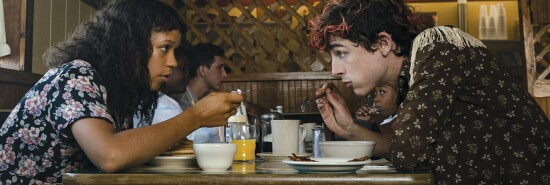
Tender horror in Bones and All
J. Oliver Conroy
Italian director Luca Guadagnino finds frequent muses in heartbreak and forbidden hunger. His film best known in the United States, 2017’s Call Me By Your Name, was a drama about a teenage boy (Timothee Chalamet) awakening to his homosexuality while summering with his intellectual family in the Lombard countryside. That movie might be said to be the first draft of themes now found in a more unsettling and darkly literal form in Guadagnino’s newest film, Bones and All.
Again, we have young people coming of age, doomed romance, repression, and subtexts, or just texts, of sexuality, ethnicity, and class. Again, we have the lean visage of Timothee Chalamet. This time, however, we also have cannibalism, rendered with a graphic and stomach-churning plausibility.
Meet Maren (Taylor Russell), a teenage girl in a small town in 1980s Virginia. She’s shy and poor and lives with her father, Frank (Moonlight’s Andre Holland), in a trailer home. We sense that Maren and Frank have relocated often, contributing to Maren’s poverty and loneliness but also, perhaps, hardening her adaptability and survival instinct.
We soon learn the cause of this rootlessness: Maren suffers from an involuntary urge to eat human flesh, and her childhood has been marked by episodes in which her self-control lost to what seems to be a rare congenital trait. Her father is not a cannibal, and she knows nothing of her mother, whom he refuses to discuss. After the latest gory incident, and having just turned 18, Maren sets out alone on a road trip. She’s headed to what she believes is her mother’s hometown to find answers about her condition.
As she moves along a series of Appalachian towns, Greyhound buses, and roadside gas stations, Maren learns there are other “eaters” living on the margins of society and coping with their hunger in different ways. She is initiated into this world by the creepy Sully (Mark Rylance, speaking in a persuasive hill-country drawl), whose avuncular eccentricity is riddled with red flags. From him, Maren learns that eaters know each other by scent. She soon meets more — including, fatefully, Lee (Chalamet, as a kind of ripped-jeans, gangly heartthrob), an itinerant young eater with whom she forms a friendship, partnership of sorts, and romance.
Driving a pickup stolen from one of Lee’s meals, Maren and Lee become a Bonnie-and-Clyde outlaw pair. They struggle to define a moral code for their eating — who makes an acceptable victim? — and slowly confess their backstories to each other. Lee has a family in Kentucky whom he sometimes visits. He has painful reasons for his exile, and his eventual disclosure is part of the emotional crux of their relationship and the film.
Along the way, we encounter other characters, often portrayed by actors against type. Guadagnino’s collaborator Michael Stuhlbarg (who played Chalamet’s scholarly father in Call Me By Your Name and a professor having a nervous collapse in the Coen brothers’ immortal dark comedy A Serious Man) appears as Jake, a denim-overalls-clad eater whom Maren and Lee meet at a swimming hole. He introduces his friend Brad (David Gordon Green), and, in one of the film’s best scenes, the seemingly fraternal overture grows uncomfortable and ominous. Chloe Sevigny also makes a cameo in a role difficult to explain without revealing too much; suffice to say that it is disturbing, and you may even watch the scene without recognizing her.
Much of this film’s charisma derives from the way it deftly blends seemingly incongruous genres — romance, horror, coming-of-age — even if the formula isn’t quite as original as it initially seems. There’s a debt to earlier doomed-couple-on-the-lam films, particularly Arthur Penn’s Bonnie and Clyde (1967) and Terrence Malick’s Badlands (1973).
Even Bones and All’s horror element, though cleverly rendered, isn’t exactly sui generis. We’ve had vampires and zombies on celluloid as long as we’ve had moving images. In recent years, movies and TV shows as diverse as the Twilight teenage fantasy series and the Netflix show Santa Clarita Diet have explored the idea that someone cursed with a reflexive appetite for flesh or blood bears a heavy burden.
The “body horror” subgenre — David Cronenberg is North America’s most famous semi-mainstream practitioner — has experienced a revival in recent years. Julia Ducournau’s brilliant 2016 French body-horror film Raw, about a lifelong vegetarian at veterinary school who realizes she suffers from hereditary cannibalism, explores similar themes as Bones and All in tighter form.
Although Guadagnino’s film is based on a young adult novel by Camille DeAngelis, a vegan who has said that her book is, in part, a parable about meat consumption, the screen version is interested in more typical, though sometimes interesting, questions of identity.
With its evocation of a class of people marked as outsiders for a trait they didn’t choose, the film has an obvious gay allegory, and it may be for this reason that Guadagnino set it in an earlier time. It also probably isn’t a coincidence that the actress Taylor Russell is biracial and her character’s father (Holland) is black. Yet the film, set against a backdrop of rural highways, farms, and deindustrialized Rust Belt towns, is more interesting as a class study: Maren and Lee span five or six states but scarcely touch a metropolitan or remotely affluent area.
Bones and All’s road trip frame is its strength and weakness, adding an element of bagginess to the two-hour, 10-minute story, which also has a tendency to double back on settings and characters. I’m not sure the film totally coheres. As a poignant portrayal of two young people trying to learn to trust, however, it’s something to chew on.
J. Oliver Conroy is a reporter and writer whose work has appeared in the Guardian, New York magazine, the Spectator, the New Criterion, and others.
